the new ruby?
She's already friends with all my friends.
She works at my school ...
and her blog might be better than mine already.
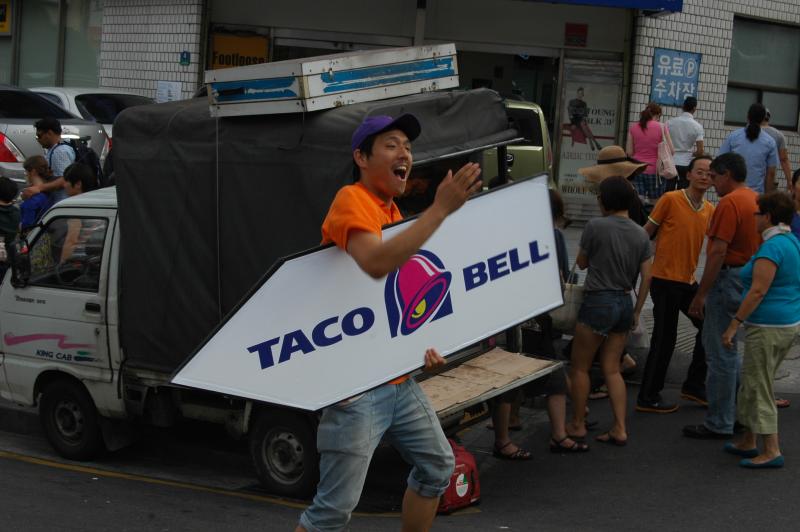
To my wonderful American / Canadian audience: I realize it might sound a little silly to write a 'Destination' post about a fast-food restaurant, but read on all the same. I write about this new establishment for a reason.
The first Taco Bell open to the Korean public officially opened in Itaewon earlier today. Although a rumor implied a 'soft opening' a few days earlier, July 11th was the scheduled date - naturally, off I went to enjoy a taste of America.
I won't claim to know the entire history of the franchise in Korea, except to say it's available on U.S. military bases in Korea (meaning you need to be part of the military or know someone), and that it was in Korea at some point in the past. ZenKimchi makes a vague reference to "the aborted attempts of Taco Bell... about ten years ago" in a post from 2008. The story I've heard (anecdotal, and possibly apocryphal) was that a franchise was opened before the Korean population was familiar with Mexican food, and before the expat population had reached a critical mass. That it was supposedly more expensive than elsewhere in the world was the final nail in the coffin.
With the resurgence in international foods around Itaewon, the area seems the perfect place to open the new franchise - and people were ready for it:
The line streamed out the door and out to the corner of the intersection nearly 50 feet away. After waiting in line for nearly 40 minutes, I made it to the front to see the menu clearly: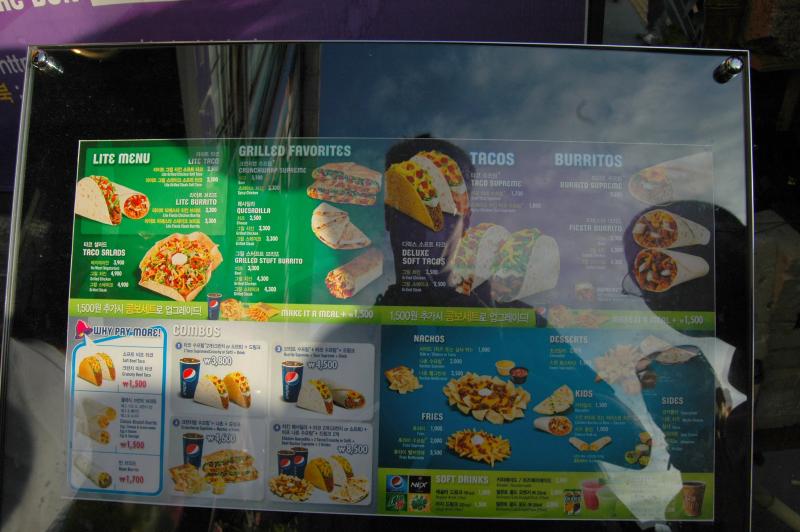
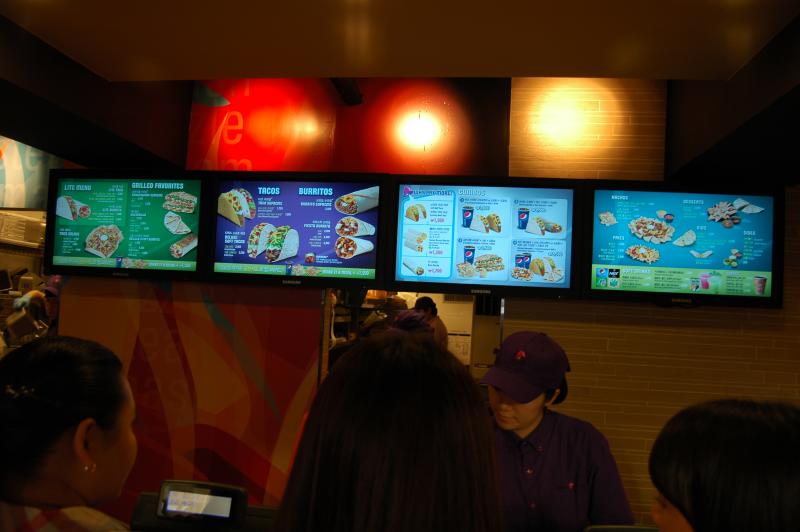
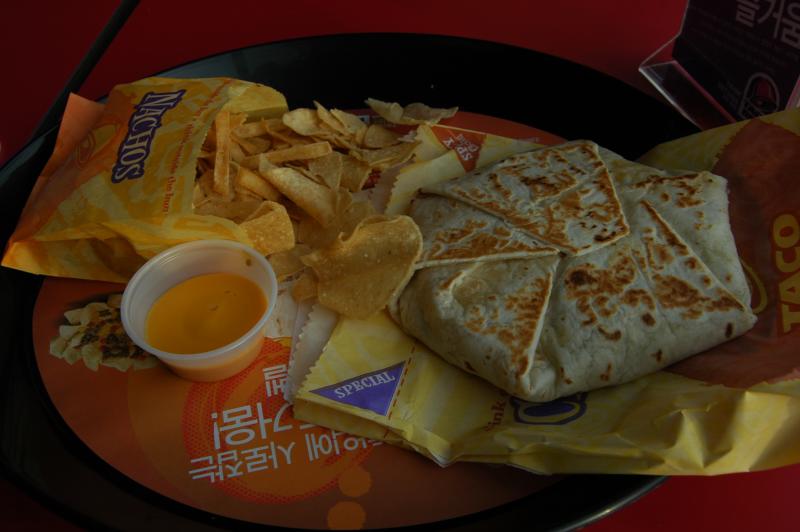
Share ![]() Bookmark this on Delicious
Bookmark this on Delicious
This post was originally published on my blog, Chris in South Korea. If you are reading this on another website and there is no linkback or credit given, you are reading an UNAUTHORIZED FEED.
Two American scholars have expressed skepticism about Seoul’s official line on the Cheonan sinking.
An international investigation concluded in May that North Korea torpedoed the South Korean warship Cheonan in late March, killing 46 sailors. North Korea denied it launched an attack and warned that any punishment would trigger war.
But Jae-jung Suh, a political scientist at Johns Hopkins University, and Seoung-hun Lee, a University of Virginia physicist, said the report issued after the investigation had numerous flaws and did not jibe with experiments they carried out to replicate the conditions caused by the type of blast that allegedly sank the ship.
South Korea’s military dismissed their claims as “nothing new,” saying it has presented sufficient evidence of an attack. The results of the experiments conducted by the professors were “likely to be based on incorrect experimental factors,” a Joint Chiefs of Staff spokesman said on condition of anonymity, citing official policy.
The international investigation concluded that the Cheonan sank after a torpedo exploded in waters about 10-20 feet (3-6 meters) away from its hull, causing a “bubble effect” and destroying the ship with its shockwaves. It said North Korea was implicated by the discovery of a torpedo fragment with “No. 1″ written on it in Korean.
The two researchers, however, said the report failed to sufficiently substantiate such claims.
“There is no evidence that the ship was destroyed by the bubble effect, or of shockwaves,” Suh told reporters at a news conference in Tokyo. “We’re not sure where it happened, we’re not sure when it happened. The only conclusion that can be drawn is that there was no outside explosion.”
Suh is the director of the Korean studies program at Johns Hopkins and the author of several books on security issues on the Korean peninsula. Lee is based at the University of Virginia’s neutron and X-ray scattering laboratory, and is an expert in the X-ray technologies used by the investigative team.
Lee and Suh said X-ray data submitted in the report contained inconsistencies that “cast profound doubt” on the integrity of the data, and said the “No. 1″ was written in ink that should have burned off under the intense heat of the blast, suggesting that it was fabricated.
Fifty-eight sailors were rescued from the frigid Yellow Sea waters near the Koreas’ maritime border but 46 perished in South Korea’s worst military disaster since the end of the three-year Korean War in 1953.
Though skeptics are in the minority, questions over the details of the sinking have been raised in South Korea since the report was released.
South Korea’s military has taken steps to dispel skepticism among some left-leaning civic groups and influential bloggers.
Last month the Defense Ministry began sponsoring a series of briefings to explain the results of the investigation to the public and offer tours of the ship’s wreckage.
Participants are allowed close access to the Cheonan and to blog about all matters discussed at the briefings — an unprecedented loosening of the military’s strict security protocols, according to the ministry.
Seoul says the investigation turned up firm evidence indicating North Korea sank the ship and has been lobbying international support for punishment of its communist neighbor. After more than a month of closed-door discussions, the U.N. Security Council approved a statement Friday condemning the sinking without explicitly saying that North Korea was to blame.
Lee — who said he has received no support from North Korea — declined to speculate on what might have caused the ship to sink if not a North Korean torpedo.
“We do not know. Nobody knows at the moment,” he said. “Grounding remains a possibility, and an accident remains a possibility. Since we cannot rule these things out, we must reopen the investigation.”
I’m concerned Seoul has allowed little room for itself or others for alternative views. And, that rigidity could also encourage the propagation of conspiracy theories.

Powered by ScribeFire.


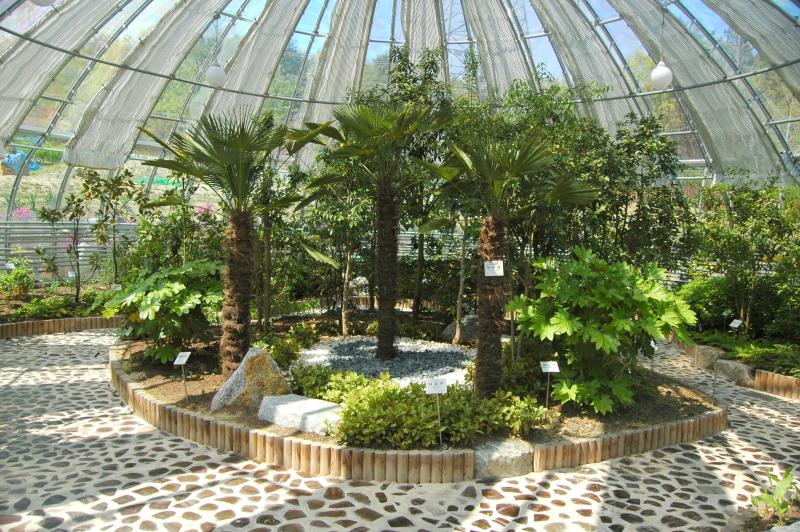
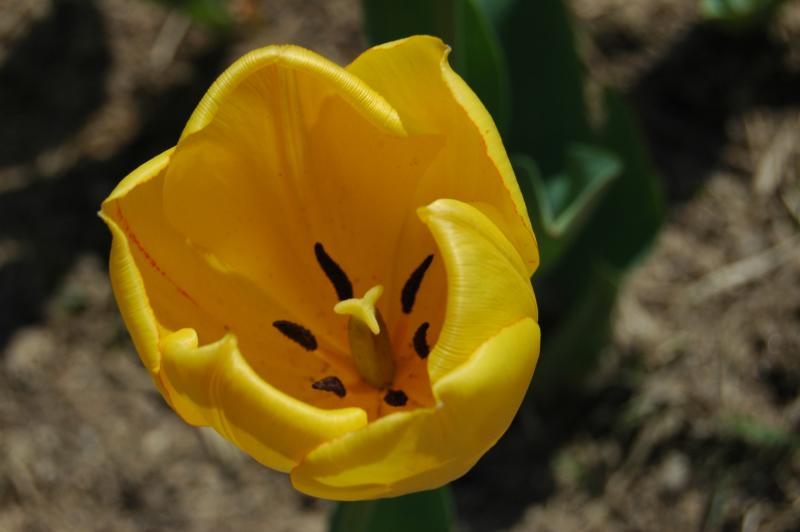

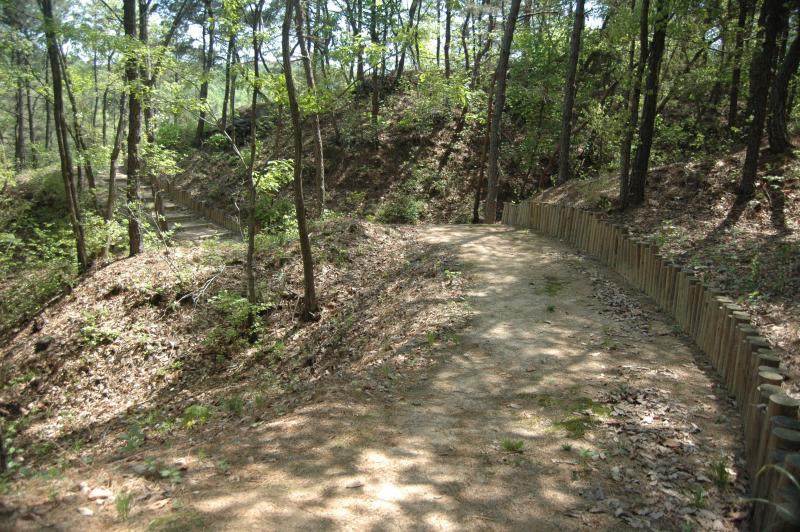
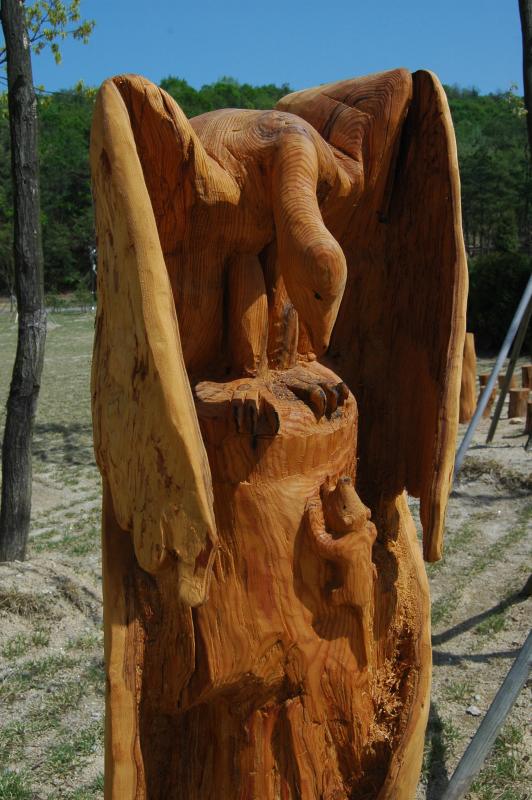

Quiet, relaxing, and beautiful - it's hard to ask for much more. Make this the place to bring a picnic lunch place, but be sure to pack it in - and out - as there's no food or drink for sale within the arboretum. Yeoju is an easy day-trip from Seoul, but make it a weekend to see the tomb of King Sejong, Empress Myeongseong's birthhouse, and Silleuksa.
Ratings (out of 5 taeguks):
Ease to arrive:
Foreigner-friendly:
Convenience facilities:
Worth the visit:
Directions: Go to Yeoju in Gyeonggi-do. From Seoul's Express Bus Terminal, buses go to Yeoju's Express Bus Terminal every 30-40 minutes. Exit out the main entrance of the Yeoju bus terminal (where the taxis line up), then turn right and walk about 50 meters to the bus stop. Look for bus 51-6 (seven buses a day, 1,000 won, 20 minutes) or take a fairly cheap taxi ride. Open 9am-6pm March-October; 9am-5pm November-February. Free admission; some areas wheelchair / stroller accessible. For more information, call 031-887-2744.
This post was originally published on my blog, Chris in South Korea. If you are reading this on another website and there is no linkback or credit given, you are reading an UNAUTHORIZED FEED.
I’ve just had an article posted on gonomad.com about a trip into the mountains of Western Sichuan Sarah and I took whilst in China last year.
If you’re interested, the full article is available at the below link.
Tagong: The Wild West of Sichuan Province
In addition to the weapons sales and tunnel expertise the DPRK is trading for Burmese raw goods, including food,
Yangon is helping to extend Iran’s strategic reach in Southeast Asia.
…the Burmese military regime has recently boosted ties with Iran, which according to the UN report is also allegedly receiving nuclear and missile technologies from North Korea.
In recent years, Burmese and Iranian officials visited their counterparts homeland for the purported purpose of improving economic ties. Observers, however, said Than Shwe has made a tactical decision to develop relationships with other “pariah states,” particularly enemies of the US, to relieve Western pressure on his regime.
Iranian Deputy Foreign Minister Mohammad Ali Fathollahi met Burmese Foreign Minister Nyan Win and Minister of Energy Lun Thi during his trip to Burma on June 15-17.
“The two sides reiterated their desire to further expand the ties of friendship and economic cooperation and to increase cooperation in the regional international forums such as [the] United Nations and Non-Aligned Movement,” The New Light of Myanmar reported on June 18.
Fathollahi’s visit came three months after Maung Myint’s visit to Iran on March 8-11, when he met Iranian Foreign Minister Manochehr Mottaki and Deputy Minister of Petroleum H. Noghrehkar Shirazi.
via North Korea Leadership Watch
The Economist has greater depth on Yangon’s progress on nukes and missiles.
Rimours that Myanmar is the next recruit to a shady nuclear and missile network that seems to link North Korea, Iran, Pakistan, Syria and possibly others swirl intermittently. The missile link is clearest: in all these cases, including Myanmar’s, North Korea has either sold missiles or helped them build their own. But aside from an agreement in principle in 2007 for Russia to build a small research reactor for Myanmar, there has been little hard evidence of its junta’s nuclear ambitions. The recent defection of a former major in the Burmese army, Sai Thein Win, however, and the documents and photographs he brought with him, appear to confirm Myanmar’s intent, if not yet capacity, to enrich uranium and eventually build a bomb.
Sai Thein Win handed over his evidence to the Democratic Voice of Burma (DVB), an émigré-run broadcaster based in Norway. The material has been analysed by Robert Kelley, an experienced former inspector for the International Atomic Energy Agency (IAEA), the UN’s nuclear guardian. His 27-page report has plenty of caveats: Sai Thein Win is a missile expert, not a nuclear boffin, and some of what he reports is hearsay; some drawings are crude at best; some equipment seen in pictures could at a pinch have civilian uses too. But experimental work on lasers that could eventually be used to enrich uranium and other equipment for making uranium metal, a necessary step in bomb-making, heighten suspicion. So do close links between supposedly civilian nuclear officials and the Burmese army’s “nuclear battalion”, officially the Number One Science and Technology Regiment.
All this and other evidence, Mr Kelley’s report concludes, lead to the inescapable conclusion that such work is “for nuclear weapons and not civilian use or nuclear power”. An earlier report, published in January by the Institute for Science and International Security, an independent Washington-based outfit, debunked some of the wilder rumours about Myanmar’s nuclear quest. But it also concluded that foreign companies should treat inquiries from Myanmar no differently from “those from Iran, Pakistan or Syria”. All are known purchasers of illicit nuclear equipment.
Myanmar has only a “Small Quantities Protocol” with the IAEA. This exempts it from regular inspections, on the government’s assurance that it has nothing to inspect. Sharper questions are now likely to be asked. The agency had already been trying to dissuade Myanmar and Russia from the research reactor. Sai Thein Win, who learned missile expertise in Russia, says that since about 2002 hundreds of Burmese scientists have trained in Russian nuclear institutes, including one formerly linked to the Soviet nuclear-weapons programme.
Sai Thein Win offers no new insight into the North Korean link. But Western intelligence agencies watch North Korea’s activities in Myanmar. There have been reports that a company associated with the construction of a secret nuclear reactor in Syria (until it was bombed by Israel in 2007 just before completion) has worked in Myanmar too.
Here is another reason the DPRK is not going away anytime soon.

After repeated diplomatic insults, I’d think Seoul would want to regain wartime OPCON from the US. Even Russia has dared to snub the Lee administration. No respect!
According to military and foreign affairs supports connected to Russia, the Russian government provided notification of its independent investigation results only to the Chinese and U.S. governments last week, and South Korea only found out about the content indirectly through those two countries.
Following this, 1st Vice Minister of Foreign Affairs and Trade Shin Kak-soo summoned Russian Ambassador to South Korea Konstantin Vnukov to the Foreign Ministry on July 4 to express “astonishment” at Russia’s investigation findings because the findings were a complete contradiction to the South Korean government’s announcement. They also expressed severe dismay about the fact that Russian notified only the U.S. and China about the findings, while leaving South Korea out of the communication loop.
Foreign affairs sources reported that Shin used forceful and diplomatically irregular language to denounce Russia’s behavior, calling it “unfriendly conduct that violates trust,” “bewildering,” and “disappointing.” It was also reported to Shin pro
osed additional discussions with Russia during the meeting, and that the South Korean government subsequently provided additional information to the Russian government.“Was it not the South Korean government that provided assistance to the Russian investigation, saying that they would be objective?” asked a former senior official in foreign affairs and national security, adding that the Russian investigation results “raise fundamental doubts about the [South Korean] government’s announcement of its Cheonan investigation findings.”
I’m not a technical expert, but it just seems to pile on insults too that the Russian investigation team into the Cheonan sinking offered more than one scenario for the sinking, which makes Seoul appear even more questionable.

Powered by ScribeFire.

Get rid of your glasses!
SMILE PRO/SMILE/
LASEK/LASIK/ICL
All types of laser vision correction at BGN!
Recent comments